Printable Quitclaim Deed Template
A Quitclaim Deed is a legal document used to transfer ownership of real property from one party to another without any warranties or guarantees regarding the title. This type of deed is often utilized in situations where the transferor may not have a clear title or where the parties involved have a high level of trust. Understanding the nuances of a Quitclaim Deed can be crucial for ensuring a smooth property transfer process.
Modify Document Online
